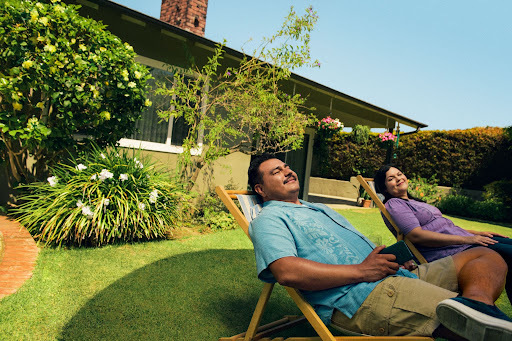ADHD-Friendly Home Organization Tips
We asked a pro for her advice, from creating zones, to setting virtual reminders.


Written by May Ortega on October 10, 2025
Edited by Jessica Rapp
Do you feel overwhelmed by clutter and traditional organizing methods that just don't click with your ADHD brain? You're not alone. The truth is, many popular organizing systems are simply not designed for neurodivergent minds. They often require complex, multi-step processes and meticulous attention to detail that can feel impossible to maintain. But organizing expert Cassandra Aarssen, founder of Clutterbug, said there's a better way.
According to Aarssen, the key to success here isn't perfection; it's creating a simple, visual system that works with your unique brain.
"Organizing doesn't have to be hard or overwhelming, and it definitely doesn't have to look like we see on TV or on social media,” Aarssen said. “For me and so many others, the inability to use traditional organizing methods — that's a system failure, not a personal one.”
This article will provide practical, simple, and effective organizing tips specifically for an ADHD-friendly lifestyle, helping you create a home that supports your well-being.
Three core principles of ADHD-friendly organization
The foundation of Aarssen's organizing philosophy is built on three core ADHD-friendly principles: decluttering, zoning, and simplifying. Using each of these approaches can help you get more organized and feel more relaxed in your home.
Tip 1: Declutter regularly
Many organizing tips start with the idea of buying bins and labels, but for someone with ADHD, this can actually make things more complicated. Instead, the first and most important step is decluttering. Before you can organize, you have to reduce the amount of things to clean up. A cluttered space can be suffocating and make it feel impossible to maintain any system you try to put in place.
Decluttering doesn't have to be a huge, all-day event. In fact, it's more effective when it becomes a continuous habit. "You have to be able to put things away like it's a basketball, and you're tossing it into a net," Aarssen said. "The container is the net, which means it's gonna be easier and faster to put things away."
So instead of taking on a big spring-cleaning project, get into the routine of decluttering at least once a week. Take a few minutes to toss out that dead pen in your office, donate a shirt you don't love from your closet, or throw away expired food in your pantry.
The goal is to reduce the amount of stuff you have to manage so that when you get to organizing, it's a much lighter lift.
Tip 2: Zone for your ADHD brain
Zoning is all about creating "neighborhoods" for your items, said Aarssen. This method bypasses the need to remember where you put something because everything you use for a specific activity lives together in one designated area. Think of your home as a series of zones rather than a collection of scattered items.
“When you zoom out and you pretend you've just moved in, you sketch out the zones on a piece of paper,” she said. “Each room is its own region, and then in there, you create little cities and neighborhoods for things that are like categories. That makes organization feel really obvious and easy, even on your worst day.”
For example, a "coffee zone" has everything you need to make your morning brew. Your "landing zone" is right by the door where you drop your keys and mail. This intuitive logic reduces mental strain and makes your space more functional.

"Where does the coffee go? Beside the coffee maker," Aarssen said. "Where do the dishes go? Beside the dishwasher. Where do your craft supplies go? Beside where you craft."
Consider organizing your items by function. All your first-aid supplies should be in one designated spot — a first-aid zone — rather than scattered throughout different rooms. Aarssen recommends sketching room by room. She said the kitchen is the easiest place to start: have a beverage zone, a breakfast zone, a cooking zone, and a dishwashing zone. Then think about what items you use in each of those zones, and start organizing that way.
Tip 3: Simplify your home organization
The final principle is to make your system as straightforward as humanly possible. Aarssen said an ADHD-friendly system should be simple; if things are too difficult to organize, it can get complicated and you may not put anything away at all.
“Nothing should be more than two steps," Aarssen said. “This means getting rid of lids, complicated latches, or anything that requires you to move one thing to access another.”
The goal is to streamline the process so that putting an item back in its zone becomes a natural, effortless habit, rather than a tedious chore. The key here is to eliminate any obstacles to putting things away. While this step may take up your time, Aarssen said you’ll thank yourself later.
ADHD organization tips by room
Bathroom: The get-ready bin
The bathroom is often a major hotspot for clutter. Aarssen recommends creating a "get-ready bin" to simplify your routine. Instead of having your toothbrush, makeup, and face cream scattered across different drawers and counters, keep all your morning essentials in one basket.
"We now only have one thing to put away," she said. "Plus, it's extra helpful because we can put in things like our medicine or our vitamins we're supposed to take. Everything is in one place, so we know we have to use everything in the bin."

Kitchen: Clutter catchers and zones
Kitchen counters often attract random clutter. To combat this, use a "clutter catcher" — a designated basket for random items you may put down in a common space throughout the day.
"Giving your random stuff a home gives it a limit," Aarssen said. “When the basket starts overflowing, it's a clear visual cue that it's time to go through the items and declutter.”
Or you could empty out your clutter catchers at the end of each day if that’s better for you.
Bedroom: Drop zones
Instead of a cluttered nightstand, Aarssen suggests trying a bedside “drop zone.” This means using a basket to store things by your bedside so you can keep your nightstand clear.
Closet: Skip the folding
If you struggle with putting away clothes, Aarssen has a hack for that. Instead of folding or hanging everything, she uses bins on shelves for things like pajamas, socks, and workout gear. If that’s too much, she said it’s perfectly fine to live out of clean laundry baskets. The key is to find a system that works for you, even if it's unconventional for others. It’s your wardrobe, after all.

Other useful hacks for organizing your home with ADHD
Use technology to your advantage
For those with a poor working memory, Aarssen said using technology is a huge help.
"Relying on technology to remind you of things is key," she said. “Use voice commands to set reminders for everything from checking on dinner to taking out the dog.”
Make use of your vertical spaces
An excellent way to maintain a tidy space is to use the walls.
“If you tend to drop your keys on a console table, install hooks right above it,” Aarssen said. “This keeps flat surfaces clear while still providing a designated, easy-to-access home for your items.”

Create “brain dump” stations to avoid clutter
To combat forgetfulness, Aarssen has stations throughout her house specifically where she can write things down for later. That means she has notebooks and sticky notes in key areas like her bedside and near the coffee maker. This allows her to quickly write down ideas or tasks before she forgets them. She also uses sticky notes for important reminders that she can place in visible spots like the fridge or her bathroom mirror.
Celebrate your organizational wins — big and small
Instead of waiting for a “perfectly clean” home, acknowledge your progress in the moment. Whether it’s taking a photo of the “before” and "after," telling a friend about your success, or simply allowing yourself to feel good about your effort, basking in the results of your hard work is important.
"If I organize the junk drawer for 15 minutes, I've got something,” she said. “I'm like, ‘Look at what I've done,’ and I feel proud. And then the next time I use that drawer, I feel proud all over again."
This process of celebrating small wins builds a chain of successes, making the next task feel less daunting and the overall goal of a more organized space feel achievable.
Q&A: Your questions on organizing with ADHD, answered
What is the best way to organize with ADHD?
The best way to organize with ADHD is to use a simple, visual system that works with your brain, not against it. Focus on three core principles: decluttering, zoning, and simplifying.
How can I make decluttering a habit with ADHD?
Making decluttering a habit with ADHD is about working with your brain, not against it. The key is to start small, remove barriers, and create a system that provides you with immediate rewards. Following Aarssen’s tips above can help ease you into this process.
What is a "zone" in home organization?
A “zone” is a designated area where all the items for a specific activity live together. For example, your coffee maker, mugs, and coffee grounds would all be in a single "coffee zone." This makes items easy to find and put away.
Creating a home that supports you, not stresses you out, is a powerful process. It’s not about achieving a flawless, magazine-ready look. It's about designing a space that makes daily life easier and less stressful for you to live in. By focusing on the core principles of decluttering, zoning, and simplifying, you can create a functional and intuitive environment that requires minimal mental effort to maintain.
And when you’re ready for a new space, keeping these organization tips in mind can help you find a new home that better fits your lifestyle. You can use Zillow to browse homes that have the features you need, like an organized mudroom or a designated home office.
Tags
Ready for a new address?
Get an instant cash offer or list with a local partner agent.
Explore selling optionsRelated Articles
Sell your home with a winning strategy
Here’s how to maximize your home sale with the right selling plan.

Build a smart selling plan
Talk to your agent about their marketing approach - especially online - to ensure you’re getting the best possible price for your home.



